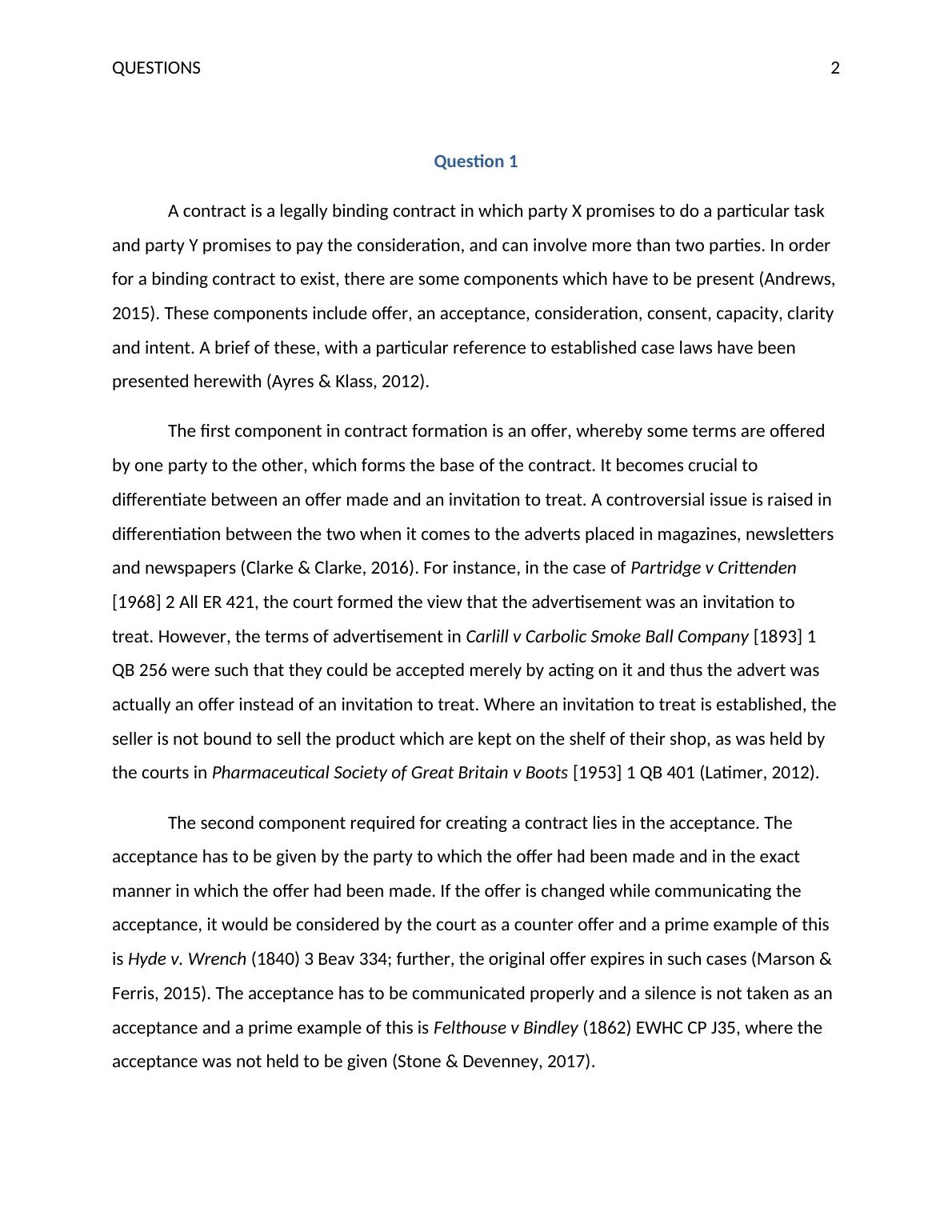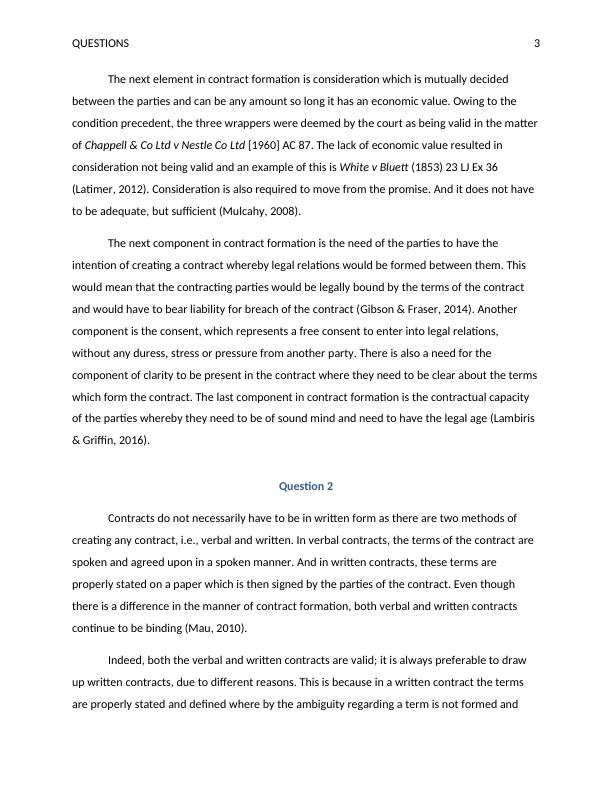Assignment | Business Law - Contract
Added on 2020-02-23
9 Pages2695 Words139 Views
Running Head: QUESTIONS1

QUESTIONS2Question 1A contract is a legally binding contract in which party X promises to do a particular task and party Y promises to pay the consideration, and can involve more than two parties. In order for a binding contract to exist, there are some components which have to be present (Andrews,2015). These components include offer, an acceptance, consideration, consent, capacity, clarity and intent. A brief of these, with a particular reference to established case laws have been presented herewith (Ayres & Klass, 2012). The first component in contract formation is an offer, whereby some terms are offered by one party to the other, which forms the base of the contract. It becomes crucial to differentiate between an offer made and an invitation to treat. A controversial issue is raised in differentiation between the two when it comes to the adverts placed in magazines, newsletters and newspapers (Clarke & Clarke, 2016). For instance, in the case of Partridge v Crittenden [1968] 2 All ER 421, the court formed the view that the advertisement was an invitation to treat. However, the terms of advertisement in Carlill v Carbolic Smoke Ball Company [1893] 1 QB 256 were such that they could be accepted merely by acting on it and thus the advert was actually an offer instead of an invitation to treat. Where an invitation to treat is established, theseller is not bound to sell the product which are kept on the shelf of their shop, as was held by the courts in Pharmaceutical Society of Great Britain v Boots [1953] 1 QB 401 (Latimer, 2012).The second component required for creating a contract lies in the acceptance. The acceptance has to be given by the party to which the offer had been made and in the exact manner in which the offer had been made. If the offer is changed while communicating the acceptance, it would be considered by the court as a counter offer and a prime example of this is Hyde v. Wrench (1840) 3 Beav 334; further, the original offer expires in such cases (Marson & Ferris, 2015). The acceptance has to be communicated properly and a silence is not taken as an acceptance and a prime example of this is Felthouse v Bindley (1862) EWHC CP J35, where the acceptance was not held to be given (Stone & Devenney, 2017).

QUESTIONS3The next element in contract formation is consideration which is mutually decided between the parties and can be any amount so long it has an economic value. Owing to the condition precedent, the three wrappers were deemed by the court as being valid in the matterof Chappell & Co Ltd v Nestle Co Ltd [1960] AC 87. The lack of economic value resulted in consideration not being valid and an example of this is White v Bluett (1853) 23 LJ Ex 36 (Latimer, 2012). Consideration is also required to move from the promise. And it does not have to be adequate, but sufficient (Mulcahy, 2008).The next component in contract formation is the need of the parties to have the intention of creating a contract whereby legal relations would be formed between them. This would mean that the contracting parties would be legally bound by the terms of the contract and would have to bear liability for breach of the contract (Gibson & Fraser, 2014). Another component is the consent, which represents a free consent to enter into legal relations, without any duress, stress or pressure from another party. There is also a need for the component of clarity to be present in the contract where they need to be clear about the termswhich form the contract. The last component in contract formation is the contractual capacity of the parties whereby they need to be of sound mind and need to have the legal age (Lambiris & Griffin, 2016).Question 2Contracts do not necessarily have to be in written form as there are two methods of creating any contract, i.e., verbal and written. In verbal contracts, the terms of the contract are spoken and agreed upon in a spoken manner. And in written contracts, these terms are properly stated on a paper which is then signed by the parties of the contract. Even though there is a difference in the manner of contract formation, both verbal and written contracts continue to be binding (Mau, 2010). Indeed, both the verbal and written contracts are valid; it is always preferable to draw up written contracts, due to different reasons. This is because in a written contract the terms are properly stated and defined where by the ambiguity regarding a term is not formed and

End of preview
Want to access all the pages? Upload your documents or become a member.
Related Documents
The Business Law Six Elements Projectlg...
|10
|2986
|36
Contract Business Law Assignmentlg...
|9
|2851
|84
Commercial & Corporation Law Assignment (Doc)lg...
|8
|1867
|49
Case Study on Commercial Law Assignmentlg...
|11
|2850
|213
MLC707 - Commercial and Corporations Law Case Studylg...
|7
|1859
|85
Contract Law Issue - Assignmentlg...
|6
|963
|73
